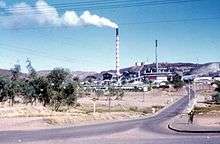1964 Mount Isa Mines strike

The 1964 Mount Isa Mines strike was an Australian eight-month industrial dispute between miners and management at Mount Isa Mines (MIM) in Mount Isa, Queensland.
Background To The Dispute
A previous 1961 strike at MIM was precipitated by legislation that threatened employees' contract bonuses. It ended with an uneasy truce when State Premier Frank Nicklin proclaimed a state of emergency, ordering unions back to work, and MIM back to the negotiating table.
The dispute erupted again in August 1964, when the State Industrial Conciliation and Arbitration Commission rejected a proposal for a weekly pay rise of £4 in lieu of an increase to the bonuses. The miners, prominently led by Pat Mackie, began to work to wage, a go slow tactic that led to reduced mine output. Dissension arose in union ranks over the direction the industrial dispute should take, with AWU leaders refusing to expand the dispute outside Mount Isa. Mackie was accused of communism and expelled from the AWU. Mackie and other militant unionists were also dismissed from MIM.
By 10 December, Premier Nicklin issued an order-in-council, demanding MIM employees return to contract work, and increasing police powers to enforce the matter. The order-in-council was quickly amended to allow the dismissal of workers unwilling to comply. MIM immediately fired 230 underground miners and locked out the rest.
State Of Emergency
Premier Nicklin declared another state of emergency on 27 January 1965, permitting police to cordon off Mount Isa, enter houses without warrant, and seize strike materials. This order-in-council was met with widespread disapproval, and was withdrawn four days later. The dispute petered out through February and March, as enough miners returned to work to resume production. A large number of workers' demands were eventually met in the MIM Award of June 1965.
The story of the dispute inspired a Queensland Music Festival musical production titled Red Cap, which premiered at the Mount Isa Civic Centre on 11 July 2007.[1]
The Role Of Brian Mullins In Breaking The Strike (National Civic Council)
Of little public knowledge is the role played by Brian and the NCC in Mount Isa in bringing to an end the great Mount Isa strike (1964–65), led by the militant left-winger, Pat Mackie. It was, as one source acknowledged, "probably the greatest labour dispute in post-war Australian history".
At the time, Mount Isa Mines was one of the largest mines in Australia, producing copper, zinc, lead and silver. Even before the strike, there had been a history of labour unrest at the mine. In 1964, wildcat strike action was taken by sections of the workforce, without the approval of the Australian Workers Union (AWU), which then covered the workforce.
Communist Influences
The prime mover in this was Pat Mackie, a New Zealand-born, but Canadian-trained activist, who was a member of a Marxist revolutionary group, the Industrial Workers of the World.
Mackie brought in Alex McDonald, the communist secretary of the Queensland Trades and Labor Council, to legitimise the strike. Other communist union officials converged on Mount Isa as part of the Communist Party's bid to destroy the arbitration system, and as part of a concerted campaign to exclude the AWU from major resource projects and to replace it with communist-controlled unions.
Various union officials visited Mt Isa at various times, during the strike. These included the President of the QLD Trades and Labour Council, John known as Jack Egerton, who was a member of the ALP (Australian Labor Party) and Edward John (known as Jack) Hanson, President of the TLC Disputes Committee. It was normal practice for people holding these positions to be involved in negotiations around a long running strike. Jack Hanson was a member of the CPA. He and his wife were also on a committee to provide material relief to families of the workers affected by the strike. As it continued so long there was considerable hardship. The goods were mainly sent by train from around QLD especially from Brisbane. personal history, photo from Courier Mail of Jack Egerton and Jack Hanson arriving at Mt Isa airport 1964 and Forum by Brisbane Labour History Society, c 2000. speakers including Keith de Lacey, who wrote and researched a book called 'Blood on the Wattle', which though fiction is closely based on the Mt Isa Mine dispute 1963-4).
Mackie Vs. Mullens
When it became obvious that the strike was not a genuine industrial dispute, Brian Mullins went to Mount Isa for an extended period to galvanise into action the considerable number of unionists opposed to Mackie.
As he later commented to a colleague, "It was Mackie versus Mullins" until the strike collapsed. Brian stated later that violence of one sort or another plagued Mount Isa during the strike, and one of his associates was killed in a motor vehicle accident which occurred during a car chase through the streets.
When Pat Mackie later attempted to agitate in the sugar-cane industry, Brian assisted cane-growers to resist him, and Mackie's efforts to mobilise workers in this industry came to nothing.
In the 1960s, universities across Australia became battlegrounds as the radical left sought to transform these institutions from centers of learning into centres of radical action and political confrontation.
Brian was in this struggle right from the start, and Queensland students were encouraged and trained to become active in the Australian Union of Students, the national student organisation which the extreme left had captured in pursuit of its own ideological agenda.
Brian Mullins brought together academics such as Dr Rupert Goodman and Professor Peter Lawrence and NCC-trained students in the common cause of defending the integrity of the nation's universities.
References
- ↑ "Experiment in inclusion - The Australian". Theaustralian.news.com.au. 28 September 2012. Retrieved 2012-10-05.
- Nicklin, Sir George Francis Reuben (Frank) (1895 - 1978), Australian Dictionary of Biography
- SMH obituary for Sir George Fisher
- Migrants and Class in Postwar Society
- Brian Mullins (1925-2009): a true Australian hero
Coordinates: 20°42′58″S 139°28′34″E / 20.7161°S 139.4760°E